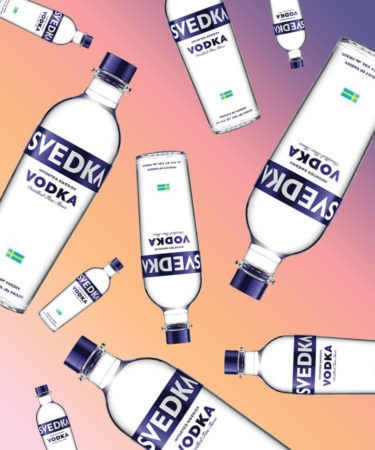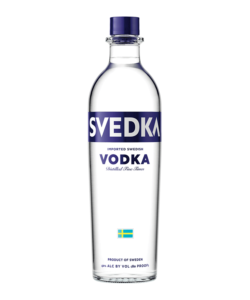Even if you’re not a vodka fan, you might already know the name Svedka. This could be because of the aggressive marketing campaign the brand launched in the mid-aughts featuring a provocative human-like female robot. Or, it could be because the Swedish brand has been on the market for more than 20 years.
Although the robot was eventually dropped as a “spokesperson,” Svedka remains a top-selling vodka today. Before you buy your next bottle, read on for nine more things you should know about Svedka.
Svedka is super-Swedish.
Vodka can be Russian, Polish, French, Diddy-esque, and Texan, but Svedka is famously Swedish. Although it isn’t the only vodka from Sweden (there’s that other iconic brand, and a few more), Svedka is a combination of the words Svenska, which means Swedish, and vodka. The brand was founded in an idyllic 580-ish-year-old town called Lidköping in the southern part of the country.
Svedka is 22 years old, with centuries of tradition.
The origins of vodka may be disputed (Russia, Poland, Sweden, etc.), but regardless of where the spirit was first distilled, it’s an old invention. Sweden has been making vodka for hundreds of years, since as early as the 15th century (though Swedish distillers didn’t really get the process down until the 17th and 18th centuries, as drinking spirits became more popular).
Svedka was founded in 1998 by Guillaume Cuvelier, who later sold the business to Constellation Brands in 2007. (He then opened his own spirits company, Davos.)
Svedka is distilled from Swedish winter wheat, which is nice, but doesn’t really matter.
If you recall from all your Vodka 101 learnings, vodka is made by repeatedly distilling a base mash until all other compounds are stripped from the ethanol, leaving behind an (arguably) flavor-free liquid. That’s why you’ll hear terms like “smooth” and “clean” when vodka is being described, and almost nobody broods over a snifter of it fireside. Svedka is proudly made with Swedish winter wheat from beautiful fields like this. The simple fact is, however, after distillation, most characteristics of the original starch source — in this case, Swedish winter wheat — are gone.
Svedka is distilled five times. For vodka, that’s not a lot.
Vodka’s distillation process strips out most everything but ethanol. The basic idea is that repeated distillations can help create a purer, cleaner-tasting spirit. Svedka is distilled five times, which might seem like a lot, until you hear that Tito’s is distilled six times, L’Chaim is distilled 18 times, and the original vodka from Purity — another Swedish vodka — is distilled a whopping 34 times (Purity also has a reserve vodka that’s distilled 51 times). There are rationales on all sides as to why an amount of distillations is chosen, so there’s no “right” number, but that doesn’t mean you can’t pretend it’s all very sophisticated as you describe your Svedka and soda at the bar.
It’s made with wheat; it’s also gluten-free.
According to science (and Beyond Celiac, a patient advocacy group for people living with Celiac disease, agrees), “pure, distilled vodka, even if made with wheat, barley, or rye, is considered gluten-free.” Again, that’s because any gluten from the base grains gets distilled out. But that doesn’t necessarily mean that people with a sensitivity to gluten should start mixing Screwdrivers. Tipplers with Celiac disease report mixed reactions to vodka, plus gluten can show up in vodka in the form of flavorings and other ingredients added after distillation. So, as with any beverage, choose your vodka wisely.
The rainbow of Svedka vodka flavors is downright Willy Wonka.
Svedka loves fruit flavors. Like, a lot. Among the Skittles-defying rainbow of flavors currently available from Svedka are: Raspberry, Blue Raspberry, Strawberry Lemonade, Cucumber Lime, Mango Pineapple, Orange Cream Pop, Citron, Peach, Strawberry Colada, Cherry, Grapefruit Jalapeño, and Grape.
There is a Svedka Rosé.
Svedka continues to innovate with its blends and flavors, and recently jumped on the rosé-all-day trend by blending 5 percent rosé wine into its rosé-flavored vodka, giving the spirit a faint hint of those light berry and floral flavors we love in actual rosé. According to the press release from Constellation, Svedka Rosé “targets palate thrill-seekers and experientialists who crave new ways to enjoy their favorite spirit.” And here I thought adding wine to your vodka was just the quickest way to make “Bad Decision Juice.”
Svedka also makes hard seltzer.
Svedka also has its own mini-line of spiked seltzers, including Strawberry Elderflower and Tangerine Hibiscus flavors. Basically, no fruit is safe from Svedka — but then again, with flavored vodkas and faux-vodka-sodas, you won’t need to buy as many mixers.
You can be the Svedka Robot Girl.
Remember that weirdly sexy robot? Svedka nixed the concept in 2013, but that doesn’t mean she can’t be revived. Svedka created a Svedka Robot Girl costume for Halloween in 2011. In its heyday, the costume sold online for anywhere from $25 to $40 (meaning, yes, wearers were paying the brand to advertise it). Considering the slim-tight sex appeal of the costume, it’s perhaps no shock that it took off, with reality-show celebrities JWoww and Kim Zolciak briefly — and gloriously — stepping out as buxom humanoid booze machines.
Svedka ran a very creepy Halloween ad campaign.
Speaking of Halloween, Svedka ran a boldly creepy Halloween marketing campaign that basically reminded us that we’re all being followed and tracked — all the time. The campaign itself was pretty simple: Banner ads would “follow you” around the internet as you scrolled, ‘grammed, GrubHubbed, and what have you. Apparently you initiate the “Banner Ad Curse” by watching a “forced-view, pre-roll video,” exactly like “The Ring,” except instead of dealing with things like landlines and VHS tapes, you just share clickbait Svedka ads via social media, and apologize — or not — to people later.

